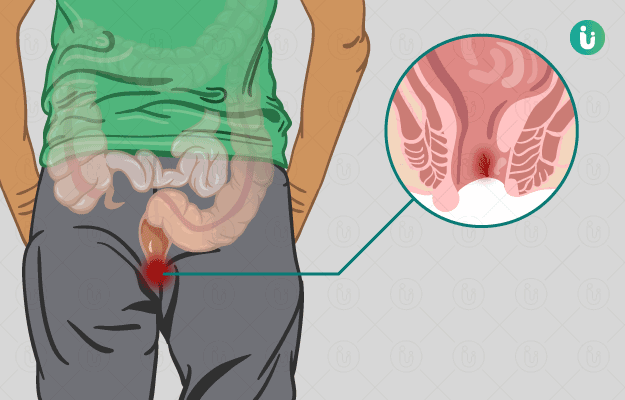What are Anal Fissures?
Anal fissures are small, narrow, oval-shaped cuts or sores in the anal canal. They usually occur in the lining of the anal canal, especially the one at the back. The anal canal is a tube-like structure between the rectum and anus. Bleeding and pain with spasm near the anus are the most common symptoms. They can occur at any age. Usually, they are confused with haemorrhoids or piles. Fissures can be acute or chronic. Acute fissures are a tear similar to a paper cut, but the chronic ones feel like a lump of the skin on the anal canal lining.
What are the main signs and symptoms?
Pain and bleeding are typical symptoms. Usually, the pain starts during bowel movement and can last for hours. Itching and swelling are also experienced. The pain intensity is tolerable, but severe pain can be experienced sometimes. Red blood spots can be seen in the stools, on the tissue paper, or around the anus. A thin crack appears on the skin of the anus. The individual is usually free of these symptoms between two bowel movements.
What are the main causes?
Anal fissures mainly arise due to the passage of hard, large stool through the anal canal owing to constipation. Inflammatory bowel disease, such as Crohn’s disease, can also cause fissures. Fissures can also occur during pregnancy and childbirth. Loose stools and persistent diarrhoea can also be the underlying causes.
How is it diagnosed and treated?
Doctors will check your anal canal by putting a gloved finger or insert an anoscope (a thin tube with a camera fitted on one end). The location of the fissure is also suggestive of the possible cause. Fissures located sidewise rather than back or front may be due to Crohn’s disease. If needed, for further diagnosis or for exploring the underlying conditions, the doctor may use flexible sigmoidoscopy or colonoscopy based on the situation of the affected person. (Consult a doctor with Doctor app)
Anal fissures can be easily treated and can resolve by themselves within weeks but can recur if the underlying conditions are not treated. Generally, a fibre-rich diet and consumption of plenty of water can soften stools and make them bulkier, thereby preventing any further damage and allowing the fissure to heal. Topical anaesthetics can be used to provide relief from anal pain. Stool softeners are also prescribed to aid the treatment.
A warm tub bath for 10-20 minutes multiple times in a day will help soothe anal muscles and induce relaxation. Narcotic pain medications should not be used since they induce constipation. Medications, such as nitro-glycerine ointment and calcium channel blockers, are used. Very rarely surgery is performed for the treatment. Surgical treatment involves botulinum toxin injection and sphincterotomy (surgery of the anal sphincter). The risk of loss of bowel control is low with surgical procedures.
(Get online doctor consultation for any health issue)

 Doctors for Anal Fissure
Doctors for Anal Fissure  OTC Medicines for Anal Fissure
OTC Medicines for Anal Fissure



















